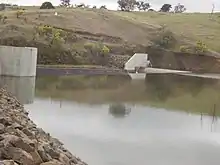Ben Chifley Dam
Ben Chifley Dam, or Chifley Dam, is a rock and earth-fill embankment dam across the Campbells River in the central west region of New South Wales, Australia. The main purpose of the dam is to supply potable water to the city of Bathurst.
| Chifley Dam | |
|---|---|
 Ben Chifley Dam | |
 Location of the Ben Chifley Dam in New South Wales | |
| Official name | Ben Chifley Dam |
| Country | Australia |
| Location | Central West, New South Wales |
| Coordinates | 33°33′22″S 149°38′12″E |
| Purpose | Water supply |
| Status | Operational |
| Construction began | 1948 |
| Opening date | 1956 |
| Operator(s) | Bathurst Regional Council |
| Dam and spillways | |
| Type of dam | Embankment dam |
| Impounds | Campbells River |
| Height | 34.4 metres (113 ft) |
| Length | 455 metres (1,493 ft) |
| Width (base) | 104 metres (341 ft) |
| Spillways | Two |
| Spillway type | Concrete side channel spillways, with a six bay auxiliary spillway |
| Spillway capacity | 9,800 cubic metres per second (350,000 cu ft/s) |
| Reservoir | |
| Creates | Chifley Dam |
| Total capacity | 30,800 megalitres (1,090×106 cu ft) |
| Active capacity | 26,000 megalitres (920×106 cu ft) |
| Inactive capacity | 4,800 megalitres (170×106 cu ft) |
| Catchment area | 960 square kilometres (370 sq mi) |
| Surface area | 2.2 hectares (5.4 acres) |
| Website www.bathurst.nsw.gov.au | |
The dam is named in honour of Ben Chifley, a former Prime Minister of Australia and Member for Macquarie.
Location and features
The dam is located 17 kilometres (11 mi) upstream of Bathurst. Water is released into the Campbells River which flows into the Macquarie River before being captured at the water treatment facility at Gorman's Hill, a suburb of Bathurst.
The dam wall is 34.4 metres (113 ft) high and 455 metres (1,493 ft) long and holds back 30,800 megalitres (1,090×106 cu ft) of water when at full capacity. The surface area of the reservoir is 2.2 hectares (5.4 acres) and the catchment area is 960 square kilometres (370 sq mi).[1] The 455 metres (1,493 ft) long uncontrolled side-channel concrete spillway and six plug auxiliary fuse plug spillway[2] has a discharge capacity of 9,800 cubic metres per second (350,000 cu ft/s).[1] With an average daily inflow of around 35 megalitres (1.2×106 cu ft) per day, as at April 2013, filtered water consumption averaged 18.9 megalitres (670×103 cu ft), with a further 8.4 megalitres (300×103 cu ft) of treated water returned to the Macquarie River.[3]
History
Construction of Ben Chifley Dam started in 1948 and was completed eight years later. It was officially opened by the Premier of New South Wales, Joseph Cahill on 10 November 1956.[2] The dam then succeeded Winburndale Dam as the potable-water supply for Bathurst. Winburndale Dam had been built in 1934 with an expected life of 20 years. Since completion of Ben Chifley Dam, Winburndale has been used to supply raw water for park watering and industrial use.
Plans to upgrade the Ben Chifley Dam commenced in 1989 after it was realised it did not meet the New South Wales Dam Safety Committee's safety recommendations and could fail in the event of a severe flood. A flood in August 1998, the worst recorded in 175 years, caused water to run over the spillway at a depth of 2.74 metres (9.0 ft), just 0.1 metres (0.33 ft) below the level at which the wall was expected to fail. An evacuation plan was implemented downstream.[4]
Construction to upgrade the dam started in 1999. The top of the wall was raised by 5.4 metres (18 ft) and the spillway was extended by 30 metres (98 ft), increasing the dam's capacity from 16,000 megalitres (570×106 cu ft) to 30,800 megalitres (1,090×106 cu ft).
Gallery
 Water flowing over the upgraded spillway
Water flowing over the upgraded spillway The reservoir impounded by Ben Chifley Dam at full capacity
The reservoir impounded by Ben Chifley Dam at full capacity
References
- "Register of Large Dams in Australia" (Excel (requires download)). Dams information. The Australian National Committee on Large Dams Incorporated. 2010. Retrieved 24 April 2013.
- "Chifley Dam - General Information". Environment: Water. Bathurst Regional Council. Archived from the original on 21 April 2013. Retrieved 11 April 2013.
- "Chifley Dam details". Environment: Water. Bathurst Regional Council. 9 April 2013. Archived from the original on 21 April 2013. Retrieved 11 April 2013.
- AG.EMADDB.Public.Website Archived 6 July 2011 at the Wayback Machine
External links
- "Macquarie-Bogan River catchment" (map). Office of Environment and Heritage. Government of New South Wales.